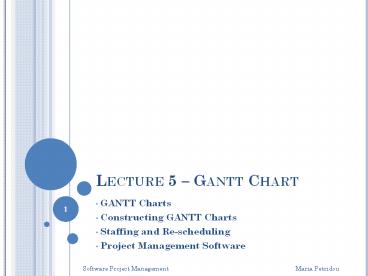Lecture 5 – Gantt Chart - PowerPoint PPT Presentation
1 / 25
Title:
Lecture 5 – Gantt Chart
Description:
LECTURE 5 GANTT CHART GANTT Charts Constructing GANTT Charts Staffing and Re-scheduling Project Management Software * Maria Petridou Software Project Management – PowerPoint PPT presentation
Number of Views:576
Avg rating:3.0/5.0
Title: Lecture 5 – Gantt Chart
1
Lecture 5 Gantt Chart
- GANTT Charts
- Constructing GANTT Charts
- Staffing and Re-scheduling
- Project Management Software
2
Gantt Chart
- A GANTT chart is a type of bar chart that
illustrates a project schedule. - After the PERT/CPM analysis is completed, the
following phase is to construct the GANTT chart
and then to re-allocate resources and re-schedule
if necessary. - GANTT charts have become a common technique for
representing the phases and activities of a
project work breakdown structure. - It was introduced by Henry Gantt around 1910
1915.
3
Gantt Chart
4
Gantt Chart
- Characteristics
- The bar in each row identifies the corresponding
task - The horizontal position of the bar identifies
start and end times of the task - Bar length represents the duration of the task
- Task durations can be compared easily
- Good for allocating resources and re-scheduling
- Precedence relationships can be represented using
arrows - Critical activities are usually highlighted
- Slack times are represented using bars with doted
lines - The bar of each activity begins at the activity
earliest start time (ES) - The bar of each activity ends at the activity
latest finish time (LF).
5
Gantt Chart
- Advantages
- Simple
- Good visual communication to others
- Task durations can be compared easily
- Good for scheduling resources
- Disadvantages
- Dependencies are more difficult to visualise
- Minor changes in data can cause major changes in
the chart
6
Constructing Gantt Chart
- The steps to construct a GANTT chart from the
information obtained by PERT/CPM are - Schedule the critical tasks in the correct
position. - Place the time windows in which the non-critical
tasks can be scheduled. - Schedule the non-critical tasks according to
their earliest starting times. - Indicate precedence relationships between tasks.
7
Constructing Gantt Chart
- Example of an early GANTT chart construction
8
Constructing Gantt Chart
- Step 1. Schedule critical tasks
9
Constructing Gantt Chart
- Step 2. Place time windows for non-critical tasks
10
Constructing Gantt Chart
- Step 3. Schedule non-critical tasks
- Step 4. Indicate precedence relationships
11
Staffing Re-scheduling
- Once the project schedule, (e.g. GANTT chart),
has been constructed, take into account - available staff hours
- slack times and
- the project schedule
- Assign staff and other resources to each activity
in the project
12
Staffing Re-scheduling
- Resource Smoothing is a technique used to
re-allocate resources and re-schedule activities. - In resource smoothing, non-critical tasks are
re-scheduled within their time window. - Staff Utilization(duration of activity x staff
required for each activity, all added together) /
(maximum staff required x duration of project)
13
Staffing Re-scheduling
Example1
14
Staffing Re-scheduling
The original schedule (constructed above) for
this project is as shown below.
1. Staff utilisation (3x24x45x17x32x14x23x
5)/(14x6) 0.857 85.5
15
Staffing Re-scheduling
2. Work out the Staff Profile
16
Staffing Re-scheduling
- Now, assume that there are 6 people available for
working in this project but one of them returns
from holidays at time2. - So re-scheduling is needed because activities A
and B cannot be carried out in parallel until
time2.
17
Staffing Re-scheduling
- Suppose another scenario in which equipment and
materials needed to carry out activities E and F
are available at time5 and time9 respectively
instead of being available at the activities ES
time. Then, rescheduling is needed but the
overall duration of the project is not affected.
18
Staffing Re-scheduling
- The obvious way to reduce the overall project
duration, it is by reducing the duration of the
critical activities. - Crashing Critical Activities refers to reducing
the duration of a critical activity by allocating
more resources to it. - The risk is that crashing activities may actually
reduce productivity and increase costs.
19
Staffing Re-scheduling
- Example 2
- Apply the PERT/CPM method and construct a GANTT
chart for the following list of activities with
precedence and duration.
20
Staffing Re-scheduling
21
Staffing Re-scheduling
- Step 1. Schedule critical tasks.
22
Staffing Re-scheduling
- Step 2. Place time windows for non-critical tasks
23
Staffing Re-scheduling
- Step 3. Schedule non-critical tasks
- Step 4. Indicate precedence relationships
24
Project Management Software
- There are a number of project management software
tools available to help in the planning and
control of large software development projects. - E.g. MS Project is a CASE software tool for
Project Management - This software is available in the main computer
room in CSIT - Most tools include functions to plan, schedule
and control, but decision-making still has to be
done by the project manager.
25
Project Management Software
- Benefits of project management software
- Calculate project schedule
- Resource smoothing
- Automatic generation of reports and charts
- Limitations of project management software
- Allocation of resources to tasks
- Estimation of tasks durations
- Make decisions
- Reading (KendallKendall, chapter 3), (Dennis
Wixom, chapter 3).































